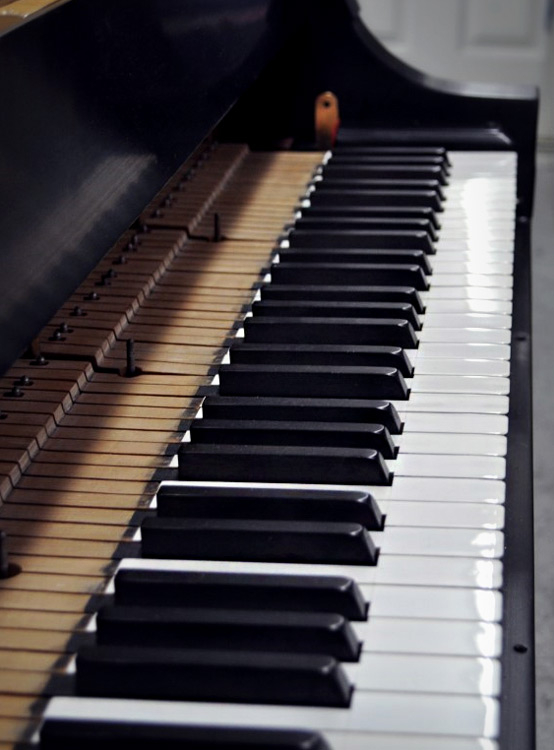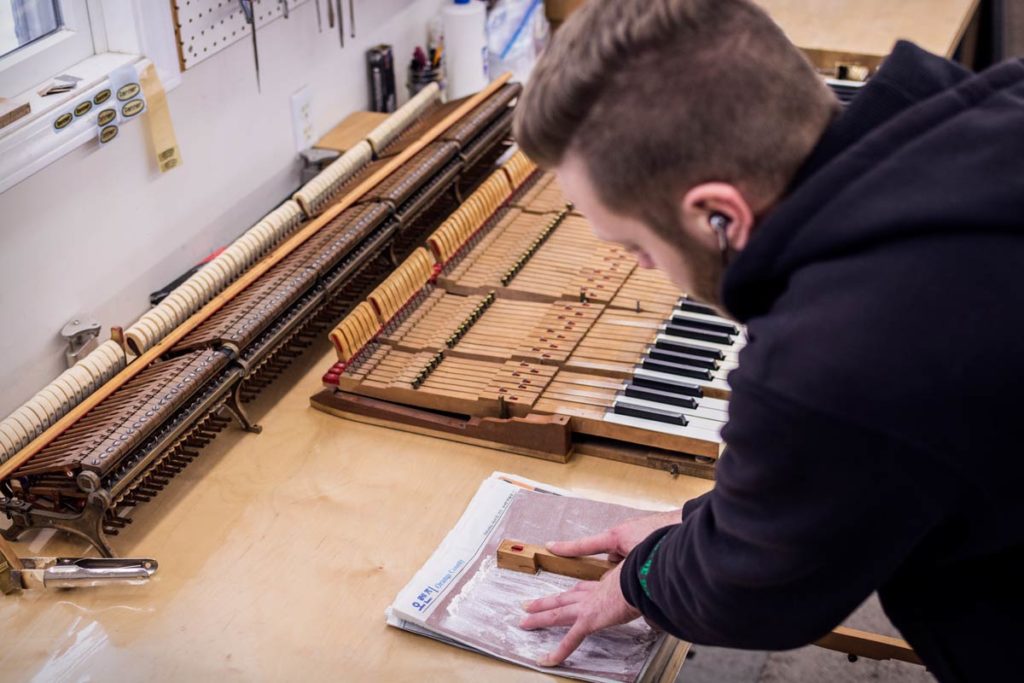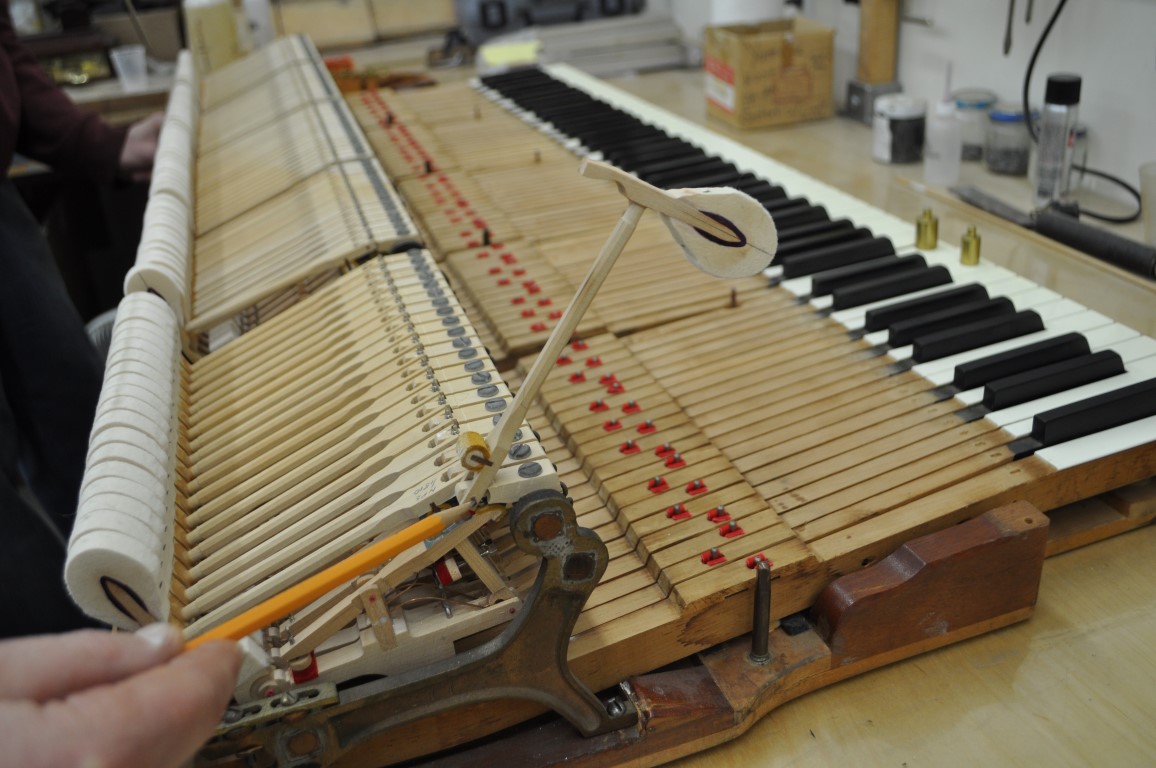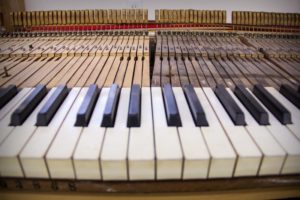
Turning Motion Into Music
The keyboard is one of the most distinctive features of any piano. Today, a traditional keyboard consists of 52 flat white keys (naturals) and 36 raised black keys (sharps) while early pianos consisted of fewer notes. What people typically think of as the piano key is generally the ivory or synthetic material that is used to cover the wooden key stick. Even the term “tickling the ivories” to denote playing a piano indicates our fascination with these beautiful key facades.
The Keytop | Ivory, Ebony & Plastics
Ivory was the material originally preferred by piano makers for use as key coverings. Thin pieces of ivory covered the tops and fronts of long wooden key sticks which are normally made of a strong, resilient wood such as spruce or sugar pine. Often, those unfamiliar with how a piano functions confuse the difference between the piano’s key coverings and the actual key.
The use of plastics grew in popularity during World War II and piano manufacturers began using it widely in new piano production in the late 1950s. This was mainly done to help minimize the cost of production.
The Switch from Ivory
First generation plastics had some issues. They did not have the age retarders they do today. Early plastic keytops yellowed quickly, became brittle, cracked and broke fairly easily. Today’s acrylic formulas don’t yellow or crack, and show their age very slowly. The first plastic keytops did not have the distinctive grip that ivory does which caused fingers to slip too easily. Technology continues to improve and modern synthetic materials imitate the feel of ivory quite well – even to the point of absorbing the moisture from your fingers as ivory does.  Steinway utilizes German Kluge ‘Ivoplast’ on their keys. Despite the popularity of plastics, ivory is still an option. An ivory embargo in 1973 stopped all importing and exporting activity, but while rare, ivory key tops are still available as long as there’s documentation to prove it’s not been illegally obtained. When restoring a vintage piano retaining and restoring the original ivory is often a viable choice.
Steinway utilizes German Kluge ‘Ivoplast’ on their keys. Despite the popularity of plastics, ivory is still an option. An ivory embargo in 1973 stopped all importing and exporting activity, but while rare, ivory key tops are still available as long as there’s documentation to prove it’s not been illegally obtained. When restoring a vintage piano retaining and restoring the original ivory is often a viable choice.
The raised black sharp key tops on vintage Steinways and other pianos were almost always made of ebony. A hard, dense and naturally dark wood, ebony provided a beautiful contrast to the gleaming white ivory. Due to rarity and cost, these keys on new pianos are now generally made of high-grade plastics or other woods although a number of makers have to decide to stick with or return to the utilization of true ebony. Often we are asked how to clean the surfaces of piano keys. We have prepared a short guide, which you can find here.
The Key | A Link to The Action

Steinway Action Stack & Key Frame
Under its cover, the key stick itself is a block of wood measuring between ten to 15 inches long. A longer key stick allows for greater control. This is one of the main differences between premium grand pianos and their upright cousins. Good quality key sticks feature wooden key buttons near the felt key bushing. This reinforces the key allowing for greater stability and responsiveness. It also helps to guide the key’s movement along pins.
The piano key is just the beginning of the complexity of the action. This wooden stick works as a lever to activate the numerous moving components inside of the action. The action is an interdependent system of levers and other moving parts which moves a felt-covered hammer to strike the piano strings from below. This causes the piano’s strings to vibrate. The vibration is transferred through the bridges to the soundboard which greatly amplifies the tone. A final part of this system is the damper. Situated above the strings, it falls to ‘shut off’ the vibrating strings when the key is released.
“Each adjustment you make to one part affects all the other parts. It’s incredibly
important to understand the precise geometry of this mechanical piece.” – Daniel Chupp
The Art of Action Regulation
The action system is a marvel of engineering – the means by which human motion is turned into music. Of the over 12,000 parts that make up a Steinway piano, over 8,000 of them are in the action. A properly regulated action gives the artist the utmost control over their playing. A piano will only produce a high-quality tone when expert tone regulation/voicing has been performed. Due to the complexity of the piano action, it is essential that qualified technicians and piano rebuilders be the ones to complete any restoration or regulation work required. For more about action restoration and regulation, click here.






